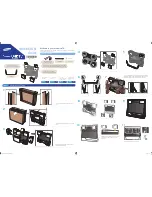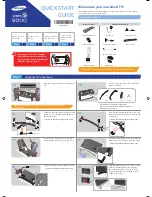
Service manual CP 385 / CP785
- 22 -
-
two selectable analogue pairs of audio baseband input (= two SCART inputs) input level: <2 V RMS,
input impedance: >25 k
Ω
- one selectable analogue mono input (i.e. AM sound): Not used in this chassis
- two high-quality A/D converters, S/N-Ratio: >85 dB
- 20 Hz to 20 kHz bandwidth for SCART-to-SCART copy facilities
- loudspeaker: one pair of four-fold oversampled D/A converters
output level per channel: max. 1.4 VRMS output resistance: max. 5 k
Ω
S/N-ratio: >85 dB at maximum volume max. noise voltage in mute mode: < 10
µ
V (BW: 20 Hz... 16
kHz)
- one pair of four-fold oversampled D/A converters supplying a pair of SCART-outputs.
output level per channel: max. 2 V RMS, output resistance: max. 0.5 k
Ω
,
S/N-Ratio: >85 dB (20 Hz... 16 kHz)
Application Fields of the MSP 3415D
In the following sections, a brief overview about the two main TV sound standards, NICAM 728 and
German FM Stereo, demonstrates the complex requirements of a multistandard audio IC.
NICAM plus FM/AM-Mono
According to the British, Scandinavian, Spanish, and French TV-standards, high-quality stereo sound is
transmitted digitally. The systems allow two high-quality digital sound channels to be added to the
already existing FM/AM-channel. The sound coding follows the format of the so-called Near
Instantaneous Companding System (NICAM 728). Transmission is performed using Differential
Quadrature Phase Shift Keying (DQPSK. Table below offers an overview of the modulation
parameters.
In the case of NICAM/FM (AM) mode, there are three different audio channels available: NICAM A,
NICAM B, and FM/AM-mono. NICAM A and B may belong either to a stereo or to a dual language
transmission. Information about operation mode and about the quality of the NICAM signal can be read
by the controlling software via the control bus. In the case of low quality (high bit error rate), the
controlling software may decide to switch to the analogue FM/AM-mono sound. Alternatively, an
automatic NICAM-FM/AM switching may be applied.
German 2-Carrier System (DUAL FM System)
Since September 1981, stereo and dual sound programs have been transmitted in Germany using the 2-
carrier system. Sound transmission consists of the already existing first sound carrier and a second
sound carrier additionally containing an identification signal. More details of this standard are given in
Tables below. For D/K very similar system is used.
Summary of Contents for DTA-20 T1
Page 17: ...Service manual CP 385 CP785 16...
Page 21: ...Service manual CP 385 CP785 20...
Page 34: ...Service manual CP 385 CP785 33 5 Circuit description 5 1 Block diagram...
Page 39: ...Service manual CP 385 CP785 38 Chassis block diagram IF...
Page 43: ...Service manual CP 385 CP785 42 Sound signal flow diagram...
Page 70: ...69 Service Manual cp 385 cp 785 7 Exploded View 7 1 DTA 20T1...
Page 73: ...72 7 4 DTA 20T8 Service Manual cp 385 cp 785...
Page 74: ...73 7 5 DTA 21T1 Service Manual cp 385 cp 785...
Page 76: ...75 7 7 DTA 21T5 Service Manual cp 385 cp 785...
Page 77: ...76 7 8 DTA 21T9 Service Manual cp 385 cp 785...
Page 79: ...78 Service Manual cp 385 cp 785 7 10 DTE 25G6...
Page 80: ...79 Service Manual cp 385 cp 785 7 11 DTE 25G7...
Page 82: ...81 7 13 DTE 28G6 Service Manual cp 385 cp 785...
Page 90: ......
Page 91: ......
















































